Thanks to our partner, Olivia Raney Local History Library, the Wake County Public Libraries: A Souvenir Centennial History: 1901-2001 is now available on our website. In this book, Roy C. Dicks outlines the one hundred year history of the Olivia Raney Library and establishing of the Wake County Public Libraries.

To learn more about the Olivia Raney Local Historical Library, visit their site here.
Thanks to our partner, the Olivia Raney Local History Library, we now have volume 1 of Wake, Capital County of North Carolina on our website.
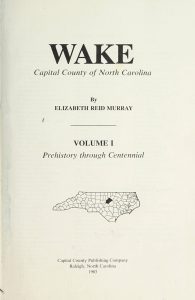
The title page of Wake, Capital County of North Carolina, Volume 1: Prehistory through Centennial.
This volume of Wake, Capital County of North Carolina focuses on the history of the region from the prehistoric era through the late 19th-century celebration of the centennial of the county’s founding. However, the bulk of the book starts with the history of eighteenth-century Wake County history. The work discusses Wake County’s role and experiences through its own history and in the context of major national and international events such as the Revolutionary War and the Civil War and Reconstruction periods.
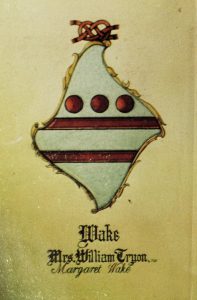
Image from Wake, Capital Country of North Carolina, Volume 1: Prehistory through Centennial.
The Olivia Raney Local History Library is a branch of the Wake County Public Library system. It houses a host of research materials on a variety of historical and genealogical topics related to Wake County. For more information about the Olivia Raney Local History Library, please visit their website.
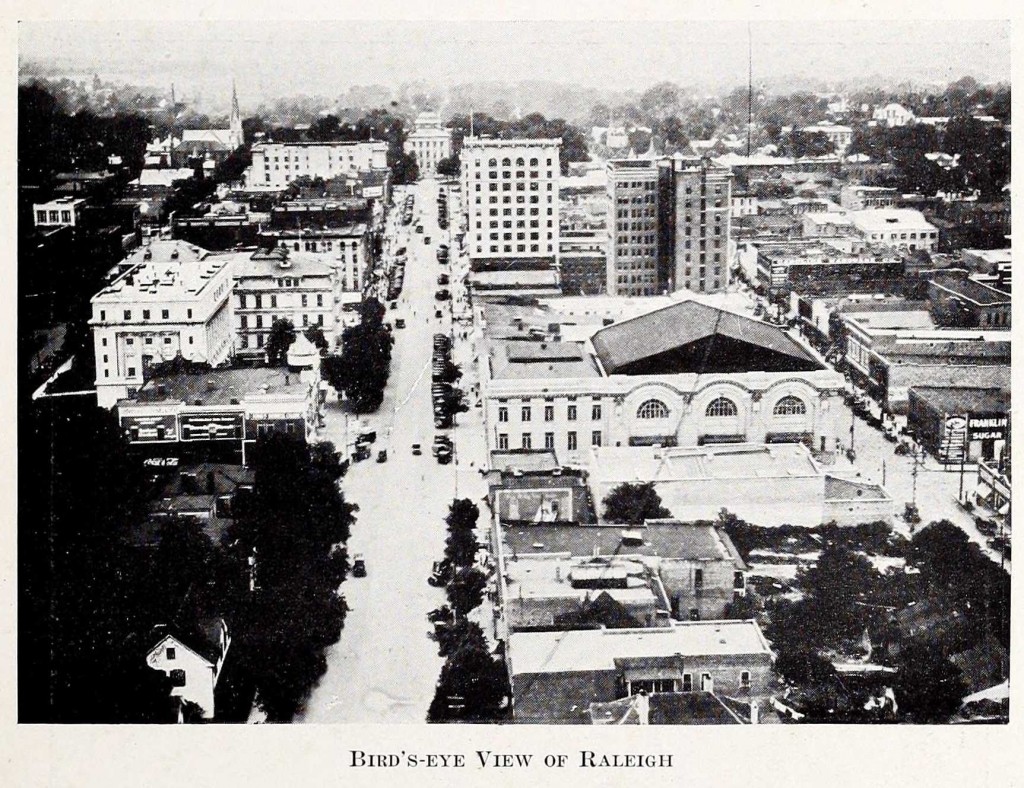
From the 1922 Rattler, Raleigh High School’s yearbook. Part of a photo essay of Raleigh.
The Digital Heritage Center partnered for the first time with the Olivia Raney Local History Library in Raleigh to digitize nearly a hundred Wake County school yearbooks, catalogs, reunion books, and graduation programs. The materials, which span 1909-2008, are windows into the daily lives and times of North Carolinians throughout the century.
Some of these yearbooks come from schools no longer in operation. Here, we’ve provided a brief history of each former school (when available), and a link to the volumes from that school (see section “Closed Schools” below). We also digitized yearbooks from schools that still exist today (see “Current Schools” section at end).
Closed Schools
Charles B. Aycock Junior High School (Raleigh, N.C.)
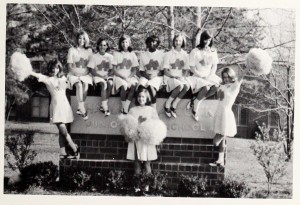
Aycock Junior High School Cheerleaders, 1969.
History: Junior high school in operation from 1965-1979, when its campus was absorbed by William G. Enloe High School, which was built in 1962. The building was and still is known as the “East Building” on Enloe’s campus. Its original students were from the recently closed Hugh Morson Junior High School (formerly Hugh Morson High School).
Volumes: Aycock [1967]; Charles B. Aycock Junior High School [1974]; six of The Owl’s Nest [1968-1973]; two of Owl’s Nest [1975-1976]
Fuquay Springs High School (Fuquay-Varina, N.C.)
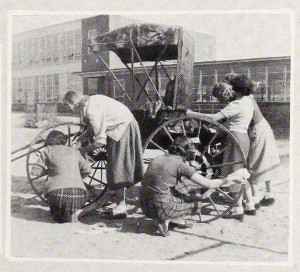
Students of Fuquay Springs High School at work, 1953.
History: Three elementary schools in the area joined together to open Fuquay Springs High School in 1918. The was renamed Fuquay Varina High School in 1963 and operated until fall 1970, when it combined with Fuquay Consolidated High School to form the new Fuquay-Varina High School. That school is still in operation today (history from Fuquay-Varina High School website).
Volumes: three of The Greenbriar [1953-64]
Hugh Morson High School (Raleigh, N.C.)
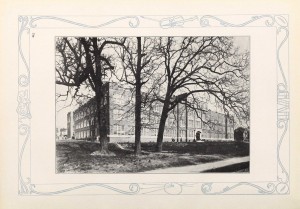
Hugh Morson High School, 1928.
History: On September 2, 1925 the students of the overcrowded Raleigh High School moved into the brand new school called Hugh Morson. The school spanned the block of Morgan Street bounded by Person, Blount, and Hargett Streets. It was named for the long-time teacher and beloved first principal at Raleigh High School, Mr. Hugh Morson. Today, all that remains is a plaque and two gargoyles. The school newspaper was The Purple and Gold; its colors, purple and gold. These colors live on today as the colors of Needham B. Broughton High School (more details in this Good Night Raleigh post; history summarized from an excellent entry in Historical sketches of the Raleigh Public Schools by Mrs J. M. Barbee, 1943).
Hugh Morson High School was demoted to a junior high school in 1955 and operated until 1965, when it closed. Over winter break in 1965, the students were transferred to the new Charles B. Aycock Junior High School and the school was officially closed and demolished in 1966.
Volumes: 18 of The Oak Leaf [1927-1955]; Morson Memories [1962]; Hugh Morson High School Class of 1955 50th Year Reunion Memorial Directory [2005]
Hugh Morson Junior High School (Raleigh, N.C.)
Volumes: PTA Year Book [1963]; Morson Junior High [1964]
Raleigh High School (Raleigh, N.C.)
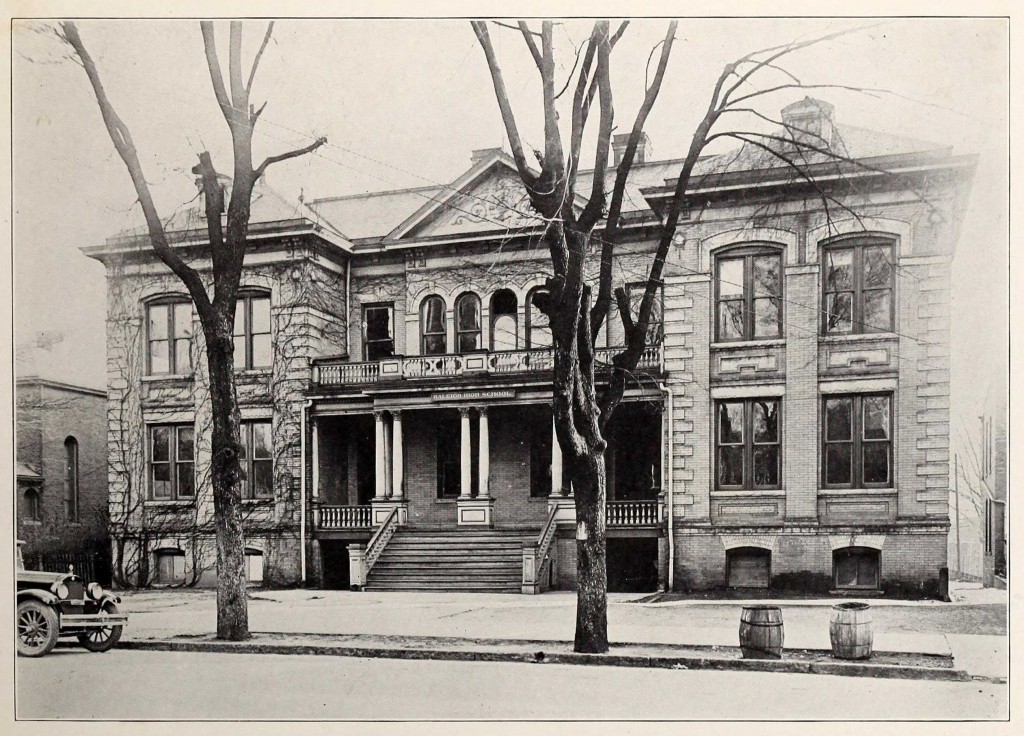
The Raleigh High School building on W. Morgan St, 1923. The school closed in 1929 and was later demolished.
History: Raleigh High School, which preceded both Hugh Morson and Broughton High Schools, was built in 1909 next to “the Raleigh water tower, across the street from fire station #1, on W. Morgan Street” (Good Night Raleigh post). The city of Raleigh decided to build a high school in 1905, reported the News and Observer. The paper also reported that the school’s principal would be Professor Hugh Morson, who ran a successful and well-known boys’ school. The West Morgan Street location was selected for its proximity to both the State and Olivia Raney libraries (the school had no library of its own). The school was built to contain 250-300 students in 1907, but enrollment was soon up to 500. The school built a two-story brick annex during 1921-1922, just east of the city water tower. But schools were soon closed during an influenza pandemic, and the buildings of the high school were used to house patients. In, fact, the school never re-opened. By 1928-1929, the building closed for good, as Hugh Morson and Needham B. Broughton High Schools had both been built. Later the building was used by the Salvation Army, and then divvied up and sold. (Note: history summarized from an excellent entry in Historical sketches of the Raleigh Public Schools by Mrs J. M. Barbee, 1943)
Volumes: seven of The Rattler [1909-1923]; Rattler [1913]; Cylinder [1924]
Rolesville High School (Rolesville, N.C.)
Volumes:Blue Devils [1960]
James E. Shepard High School (Zebulon, N.C.)
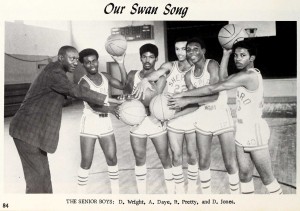
Shepard High School boys’ basketball seniors, 1970.
History: African-American high school from 1933-1970.
Volumes: The Lion [1970]
Wakelon High School (Zebulon, N.C.)
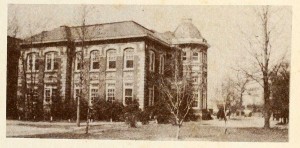
Wakelon High School, side view, 1948.
History: Wakelon School opened in 1908 in an “eclectic brick building” in Italian/Neoclassical style (National Register of Historic Places; the building was added in 1976). It was designed by C. E. Hartage, a Raleigh architect, and features a prominent center octagonal tower. The school’s construction was a big boon for the town of Zebulon, which was incorporated just a year before the school’s construction. Its construction was a result of the 1907 General Assembly act that also established Cary High School. It operated until it was merged with the integrated Zebulon Elementary. The last of the students graduated in the 1980s, and the building was sold to GlaxoSmithKline. It has since been bought back and is now a town hall.
Volumes: two of The Wak-Igh-An [1941-1948]
Washington High School (Raleigh, N.C.)
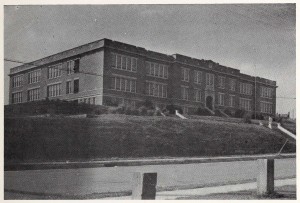
Washington High School building, 1945.
History: In 1869, a school for African-American students was built at West South Street in Raleigh by the American Missionary Society of New York. The school was bought in 1875 by the city of Raleigh and organized as a public elementary school. The school grew, but by 1918 Shaw University and St. Augustine’s College had both discontinued their high school programs, leaving Black students nowhere to pursue education beyond the elementary level. In the fall of 1924, Washington Elementary and High School opened (Historical sketches of the Raleigh Public Schools by Mrs J. M. Barbee, 1943). It was designed by C. A. Gadsen Sayre in the Jacobean style, a popular style for school architecture in in the 1920s, and continued as the only public high school for African Americans in Raleigh from its inception until 1953 (Raleigh Historic Development Commission). The building now holds Washington Gifted and Talented Magnet Elementary School.
Volumes: two of The Echo [1945-1950]
Current Schools
Cary High School (Cary, N.C.)
Volumes: three of Catalogue [1925-1927], a course catalog and campus publication with photographs of the classes and details of the curriculum; yearbooks: The Chsite [1920]; Chsite [1924], six of The Yrac [1952-1962]
St. Mary’s School (Raleigh, N.C.)
Volumes: The Muse [1917]; five of The Stage Coach [1927-1945]
North Carolina State School for the Blind and the Deaf (Raleigh, N.C.)
Now the Governor Morehead School for the Blind.
Volumes: four of The Reflector [1954-1960]
Needham B. Broughton High School (Raleigh, N.C.)
Volumes: 21 of The Latipac [1931-1964]; Needham Broughton High School Classes of 1939-1940 Reunion XXXXV [1984]; Perspectives: 50th Reunion, Class of 1958 [2008]; Journeys: NBBHS Class of 1959 50th Reunion [2009]
To view all of the new Wake County materials, click here. And click here to view all yearbooks from Wake County area high schools.

Today on the blog we’re happy to announce the addition of The Morrisville & Preston Progress, published in Morrisville from 1995-1999. This newspaper was contributed for digitization by Olivia Raney Local History Library, part of Wake County Public Libraries.
The Progress is a really interesting view into an area that has changed a lot in the last thirty years. During the span published in The Progress you can see a focus on development and growth, with articles describing the diminishing farm economy and the development around RDU airport and RTP. The article below, taken from the front page of the January 31, 1996 issue, talks about land being sold at a premium thanks to Morrisville’s convenient location.
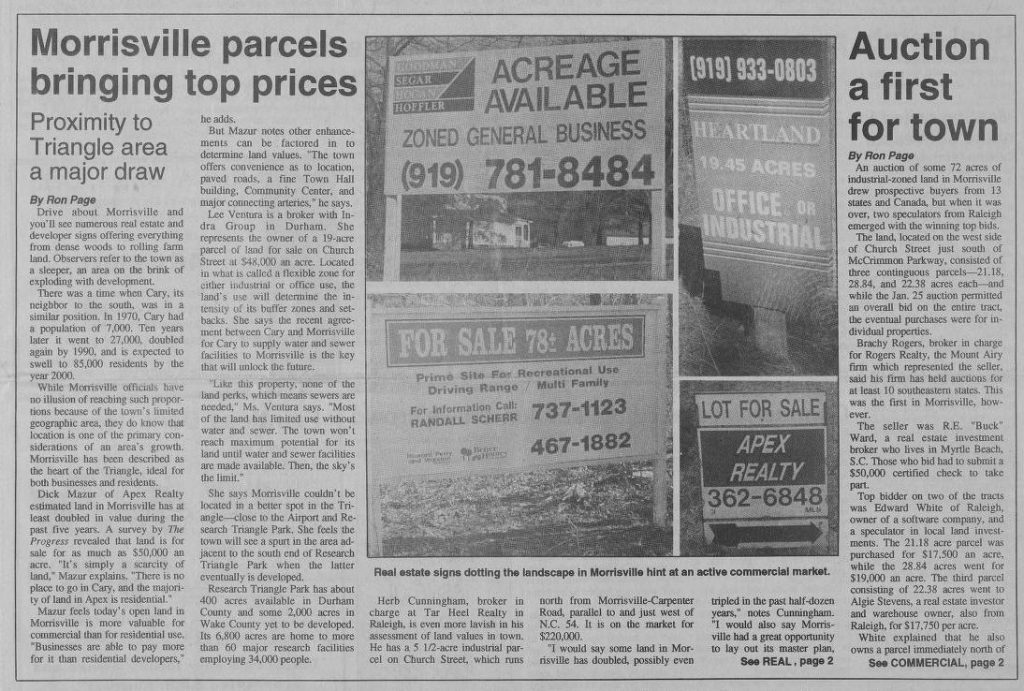
The paper also covers Preston, a community in Cary. Most of that news centers around golf; Prestonwood is a large country club with an extensive course. The September 1998 issue highlights a celebrity golf tournament, the Jimmy V Classic, that brought players like Mia Hamm, Scott Wolf, and Michael Jordan among others.
Many of the early issues include a feature entitled “Our Neighbors Speak,” which posed a current events question to Morrisville and Preston residents to get their take. Topics range from proposed federal income tax changes, to college athletics, to more local concerns. In the example below from November 1995 a number of white residents were asked their opinion about rapid growth after the population of the Triangle surpassed one million.
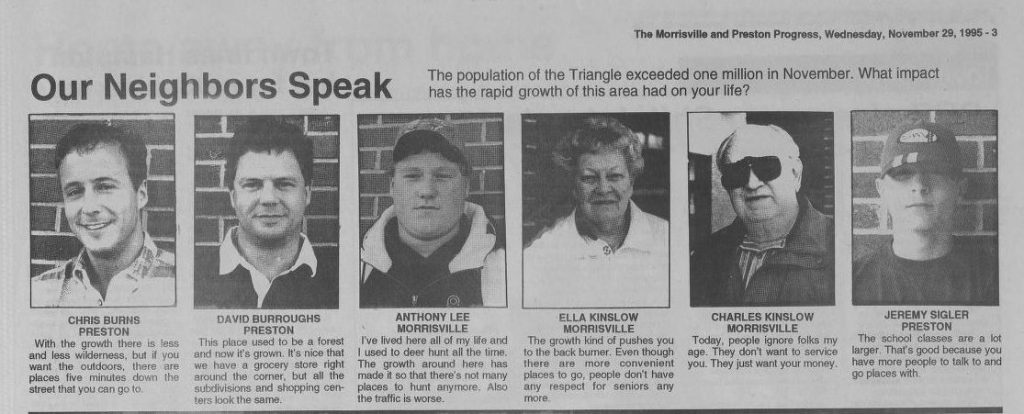
Read about Morrisville local politics (and drama!), commercial and residential development, and ongoing cultural changes in The Progress, or take a look at all of the materials we’ve digitized for Olivia Raney Local History Library on their contributor page.
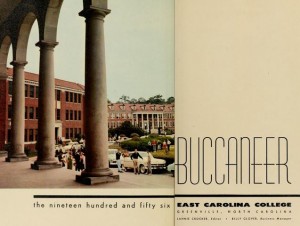
Title page from the 1956 Buccaneer, from East Carolina College, the most popular item on DigitalNC.org in 2014.
The North Carolina Digital Heritage Center had a great year in 2014. We continued to work with partners around the state on digitization projects and added a wide variety of material to DigitalNC.org, making it easier than ever for users to discover and access rare and unique materials from communities all over North Carolina.
As we look back on our work over the past year, I wanted to share some of what we’ve learned by looking at our website usage statistics. Like many libraries, the Digital Heritage Center uses Google Analytics to capture information about what’s being used on our website, who’s using it, and how they got there. While there are still lots of questions remaining about usage of DigitalNC, these stats do give us a lot of valuable information.
In 2014, more than 250,000 users visited DigitalNC.org, resulting in more than 1.8 million pageviews. While people visited our website from computers located all over the world, the greatest number by far came from North Carolina. That’s what we expected and hoped to see. More than 200,000 sessions originated in North Carolina, with the users coming from 388 different locations, ranging from over 18,000 sessions in Raleigh and Charlotte to a single visit from the town of Bolivia in Brunswick County (user location is determined by the location of their internet service provider, so this may not tell us exactly where our users are located, but it’s going to be close in most cases).
What did people use on DigitalNC? We were not surprised to find that the most popular collection remains our still-growing library of yearbooks. The North Carolina Yearbooks collection received more than 125,000 pageviews alone, followed by newspapers (44,000) and city directories (11,000). And we were pleased to learn that at least somebody is reading this blog, which received nearly 2,500 pageviews last year. The most popular blog post was our announcement about the digitization of a large collection of Wake County high school yearbooks.
We were also curious to see what single items were the most popular over the past year. The winner, with 438 pageviews, was the 1956 yearbook from East Carolina University. The second most popular was also from East Carolina, the 1930 Tecoan, followed by the 1961 yearbook from the Palmer Memorial Institute and the 1922 yearbook from Appalachian State University.
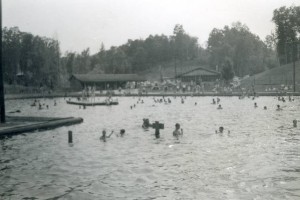
Lake Hideaway, ca. 1950s, the most popular photo on DigitalNC.org in 2014.
The most popular image on our site was from the Davie County Public Library: a black-and-white photo from the 1950s showing swimmers at Lake Hideaway in Mocksville. Other popular photos included a postcard showing the American Tobacco Company plant in Reidsville, N.C., a group of Stanly County students from 1912, and a portrait of Charles McCartney, the infamous “Goat Man” from the 1950s.
The variety of subjects, locations, and time periods in these photos is representative of the wide-ranging content available in North Carolina’s cultural heritage institutions and on DigitalNC.org. We are honored and excited to have a role in making this content accessible to everyone and look forward to sharing even more of North Carolina’s history and culture online in 2015.
















